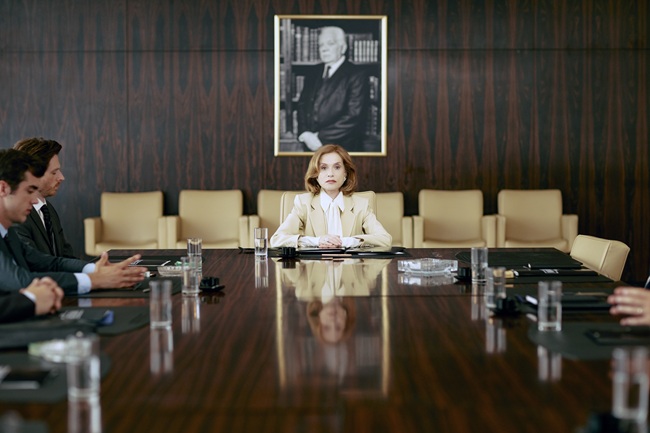Cannes Film Review: La femme la plus riche du monde
- SUBSCRIBE
- ALREADY SUBSCRIBED?
BECOME A BONJOUR PARIS MEMBER
Gain full access to our collection of over 5,000 articles and bring the City of Light into your life. Just 60 USD per year.
Find out why you should become a member here.
Sign in
Fill in your credentials below.
Cannes Film Festival loves an “eat the rich”-inspired plotline. Just look at past Palme D’Or winners, films Parasite (winner in 2019) and Triangle of Sadness (winner in 2022), both of which included heavy-handed themes about wealth, class, and power, and the ills that can befall the upper echelons (namely, untimely deaths).
Perhaps it’s not unusual then to find that La Femme la plus riche du monde (English title: The Richest Woman in the World) premiered at Cannes this year. While it wasn’t officially in competition, the Isabelle Huppert-helmed film, directed by Thierry Klifa, was a hot ticket at Cannes thanks to Huppert’s involvement alone. One of the hardest-working actresses, Huppert has a superior work ethic and has starred in over 120 feature films. She and American actress Meryl Streep can easily be called peers in terms of the sheer breadth of output, talent, and accolades for their work. (To call Huppert “the Meryl Streep of France” feels reductive to both actresses, who stand alone.)

Isabelle Huppert in 2010’s “Copacabana”
In her latest starring role, Huppert portrays a fictional woman loosely inspired by L’Oréal Magnate and billionaire Liliane Bettencourt. (If her surname sounds familiar, that may be because its synonymous with the Bettencourt affair, involving illegal payments she made in 2010 to François-Marie Banier and members of the French government who were affiliated with Nicholas Sarkozy.)
In the film, we meet Marianne Farrère (Huppert), a character based on the infamous Bettencourt. Like Bettencourt, she has millions in family money from her family’s cosmetics business. The business employs over 88,000 people worldwide, and Marianne takes the responsibility for employees’ livelihoods very seriously.

Liliane Bettencourt featured in “Banque de Tolérance” by Filip Markiewicz (2010). Wikimedia commons
When Marianne is asked to be the cover star for the newest issue of a magazine amusingly titled Selfish, she is reluctant to participate. Marianne’s daughter, Frédérique, tells her warily, “People in France hate the rich.” Eventually, Marianne agrees to the shoot, and when the electric-bike-riding gay photographer, Pierre-Alain (Laurent Lafitte), shows up to take her photo at her grand manse, he is flirty, charming, and silly. Marianne, who has long suffered from depression and back pain, immediately feels lighter and happier in the company of the buoyant and lively photographer. He playfully teases her about her hair, telling her, “I’ve seen more life in the hair of a baby doll!” He asks her to change her trousers; the ones she’s wearing, he tells her, won’t work.
After the fateful photo shoot, the pair strike up a friendship. Marianne invites Pierre-Alain into her world of wealth, privilege, and decadence. He invites her into his: nights out spent dancing at gay nightclubs, and more. “I want our friendship to go down in history,” Marianne tells him one day. “Maybe you’ll build a foundation with both our names.”
Marianne’s daughter, Frédérique, is suspicious of Pierre-Alain’s motives and his closeness with her mother. Unlike how her mother did with her, Frédérique is raising her son more simply and austerely. When Marianne attempts to give her grandson “his first million” via check at his bat mitzvah, Frédérique is horrified and says no.
During a shared family vacation at Marianne’s posh vacation home by the sea, Frédérique calls him a “freeloader” and intentionally causes him to get sunburnt. Pierre-Alain is on the vacation with his longtime boyfriend, but he continues to flirt with Marianne.
After a death in the family, Marianne and Pierre-Alain’s friendships suffers ups and downs. Eventually, it’s clear that Frédérique – as well as Marianne’s loyal and protective butler, Jerome – is right to be suspicious. Pierre-Alain is becoming a nuisance and a Rasputin-like figure (Jerome even calls him “Rasputin”).
He asks the butler, Jerome, to refill his bike with gas, and he threatens to pee in the bushes. “It’s not my job,” says Jerome, with an expressionless face as he can barely hide his detest for Pierre-Alain. When Marianne refuses to sign papers to give him money for a studio, he becomes enraged. Pierre-Alain may be charming and a good time, but he is also unhinged, unstable, and erratic. He is harsh and insulting towards cleaners and other service professionals. And yet, even despite all his negative traits and dramatic outbursts toward Marianne, he says he wants to marry her after she is widowed, and control her money. This is to the dismay of Pierre-Alain’s boyfriend, and Marianne’s daughter. “He’s not a dandy, he’s a bully,” Frédérique accurately notes.
When he tries to marry her mother, Frédérique puts her foot down. She says she will take her mother to court if needed. She’s worried about her mom’s mental state. “Only the devil would suggest something so amoral,” says Frédérique of the marriage plot. Jerome tells her it was actually her mother’s idea.
While this movie had a lot of potential, given an all-star cast that included Huppert, I noticed audience members in the press screening of the film at the Cannes Film Festival laughing during serious parts of the movie. Eventually, members of the press slowly and quietly trickled out of the film mid-screening. In total, 11 audience members left early, which speaks to the film’s pacing and ability to grab the viewer. Cannes is an unforgiving place for films that fail to captivate.
Lead photo credit : La femme la plus riche du monde. Photo credit: Cannes Press Office
More in Cannes film festival, isabelle huppert




